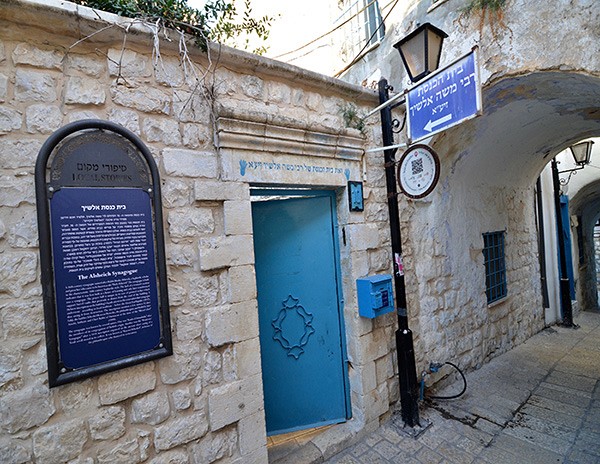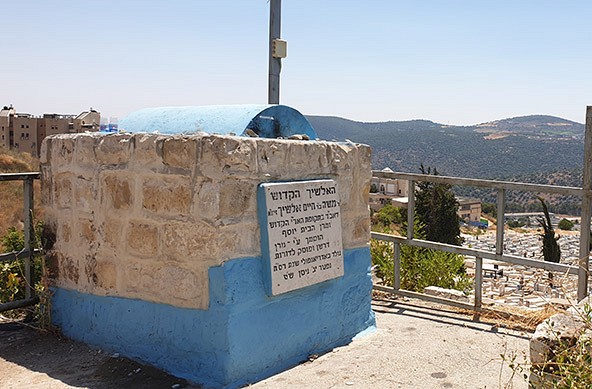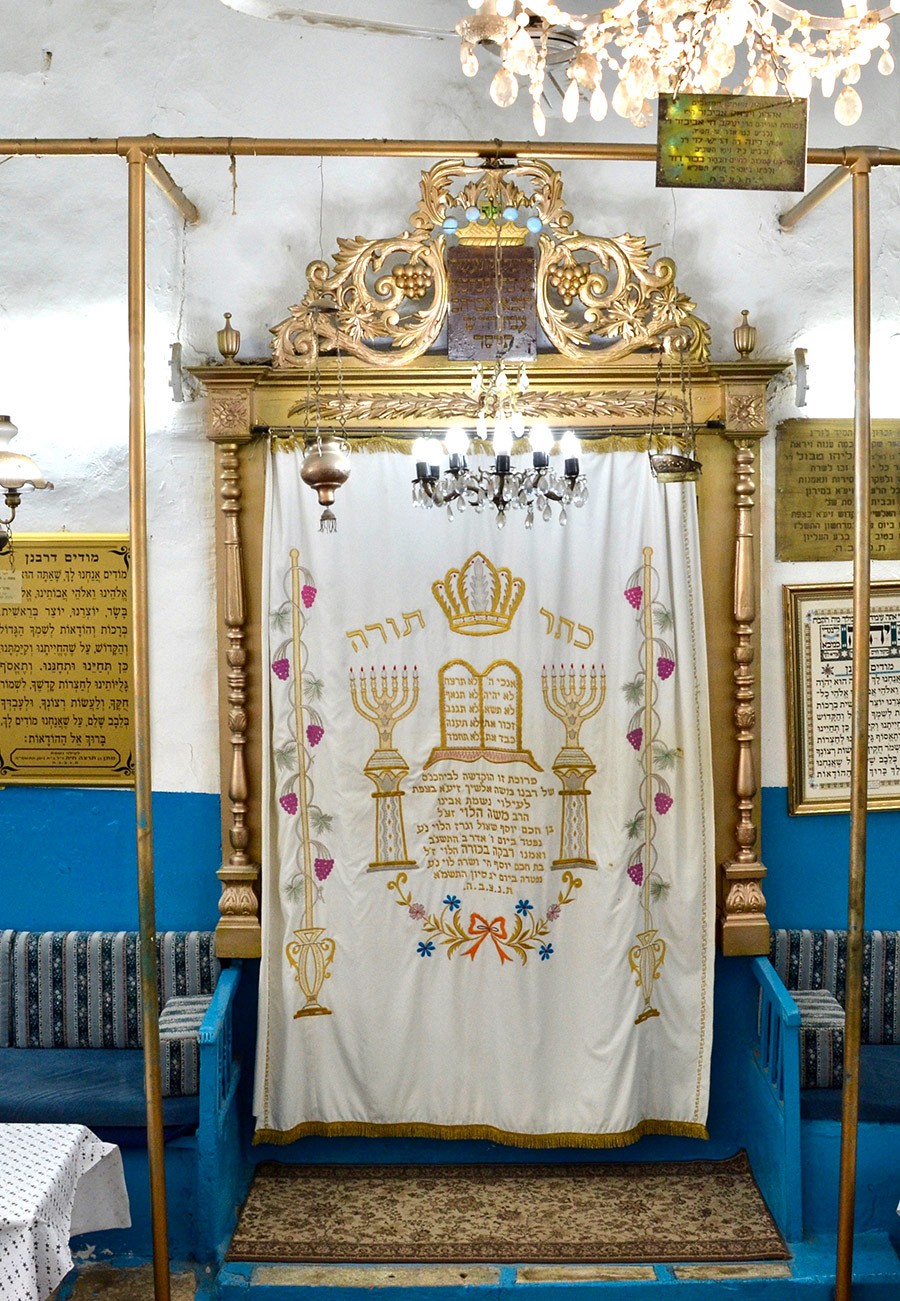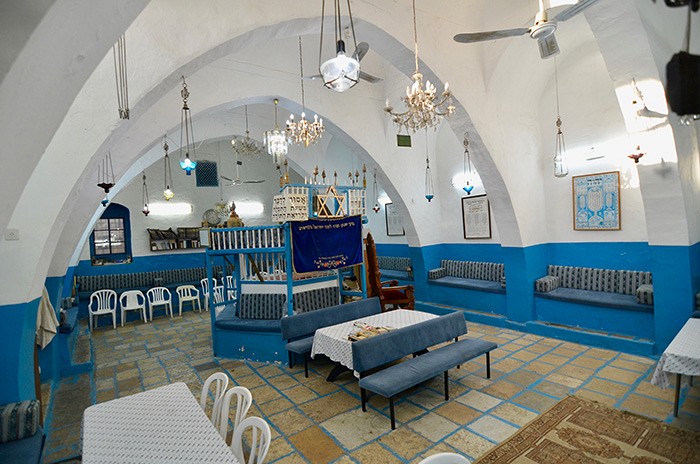The Alshich

Biography: His Life and Legacy
R’ Moshe Alshich was born in Adrianople, Turkey, in the year 5268 (1508). His father, R’ Chaim Alshich, had come with his family to Adrianople at the time of the Expulsion from Spain in 1492.
Alshich’s father started him on the path of the serious study of halacha, sending him to learn under R’ Yosef Taitatzak in Salonika. Afterwards, Alsich became the student of R’ Yosef Caro, author of the Shulchan Aruch (the Code of Jewish Law), who had also come to Adrianople from Spain because of the Inquisition.
R’ Caro raised Moshe like his own son. Around the year 1535, R’ Caro moved to Tzefas (Safed), for the Maggid who taught him Torah had instructed him to immigrate to Eretz Yisroel – and Alshich went with him. R’ Caro remained Alshich’s rebbe and mentor until the day he died.
Tzefas was a flourishing city in the sixteenth century, with many expatriates from Spain. Indeed, a letter written in 1535 describes Tzefas as having flowered unbelievably in the preceding decade, excelling particularly in the manufacture of fabrics. R’ Caro himself writes that the city experienced an “ingathering of exiles” such as had not been seen in 1500 years. The leadership was comprised of pious people, who honored and respected the Torah authorities and did nothing without consulting them; the scholars who dedicated their lives to the study of Torah were supported by the community and exempted from taxes.
The central rabbinic body in Tzefas was called the Beis HaVa’ad, and it was recognized by the non-Jewish authorities as the governing body of the Jewish community It was headed by R’ Caro and Mabit (R’ Moshe ben R’ Yosef miTrani). It decided halachic issues, and set communal policies and standards, correcting religious failings where needed.
In fact, this group decided issues not only for Tzefas, but for Jewish communities around the world. Thus, we find that the Beis HaVaad sent a letter to “our brothers, those who fear God, the leaders of the generation in every city” to strengthen religious observance. Alshich was a leading member of the Beis HaVa’ad, and when R’ Yosef Caro and Mabit died, he became the head rabbi (מָרָא דְּאַתְרָא) of the community.
In his introduction to Toras Moshe, Alshich wrote that from his youth, he spent his nights learning Gemara in depth while dedicating his days to halacha. He was not interested in spending too much time on pshat (the plain meaning of the Biblical text) and derash (homiletic interpretations); he perused those subjects only on Erev Shabbos, relaxing a bit from the rest of the week’s more demanding studies. On Shabbos, he would impart the wisdom gleaned from his Chumash studies in lectures given in halls packed to capacity with appreciative audiences. Among others, these discourses were attended by Arizal (אֲרִי ז"ל), who also told his students to attend, saying, “Let us hear Torah from the holy mouth of R’ Moshe Alshich, who merited revealing one of the [seventy] facets of the Torah.” Alshich writes that for many years he would find time after Shabbos to write down what he had said during his weekly lecture, and that these notes formed the basis for his Torah commentary.
When R’ Yaakov Beirav (Mahari Beirav) reinstituted semicha, the first person he ordained was R’ Yosef Caro, who then ordained Alshich. Indeed, inscribed on Alshich’s tombstone in Tzefas are the words: Husmach al yedei Maran – “ordained by our Master [i.e., R’ Yosef Caro].” Then, as the primary rebbe of R’ Chaim Vital in the revealed portions of Torah, Alshich continued the chain of semicha by conferring it upon his illustrious student.
Alshich was a noted halachic authority. His book of responsa contains 140 teshuvos, and he wrote other responsa as well. One responsum he wrote to a question in Jewish law was praised and accepted by R’ Yosef Caro himself. But Alshich is known best for his Torah interpretations, many of which he shared in his homilies and discourses. In Shem HaGedolim, Chida describes Alshich’s approach as explaining the Torah by incorporating material from Chazal along with hints of chochmah and mussar. He declares that Alshich wrote a commentary on Tanach that is “sweet and true,” and calls him ha’mefaresh hagadol ba’Acharonim (the great commentator among the Later Authorities).
Indeed, Alshich’s tombstone in Tzefas states that he was darshan u’posek l’doros, “preacher (or, expounder) and halachic decisor for [all] generations” – placing darshan before posek.

The End of The Alshich's Life
The good days in Tzefas didn’t last. Like in the rest of the country, people suffered from poverty, starvation, illness, and early death. Between 1550 and 1587 the problems grew more acute, with attacks, plagues, and droughts affecting the entire community. However, they did not ask for outside help until the community was literally in danger of being lost. By 1591, people were dying of starvation; there was no work or commerce. But worst of all was the terrible taxation by the authorities. Over 90% of the populace left the city, dwindling from 5000 men (i.e., heads of families) to around 400.
Finally, the remainder of the community approached Alshich and two more elderly men about going abroad to gather funds. They deliberated for three days, for if they went, they might die; but if they didn’t… Alshich embarked with two others on fundraising trip to Constantinople, spending all of 1592 there. The people responded generously, even making pledges for the next five years. He planned to go on to Venice (Italy), but he was getting weaker, and the death of one of his colleagues convinced him to return to Tzefas. However, he composed a lengthy epistle to the Jews of Italy, entitled Chazus Kashah (see Yeshayahu 21:2), where he enumerated Tzefas’s problems. He gave ten reasons why they should help save the city, including the fact that God would surely be angry if a place where He had gathered together Jews who had been scattered (see Yirmiyahu 31:9), a community that had flourished for 100 years, would be allowed to die.
The year of Alshich’s death is uncertain. His tombstone states the date 13 Nissan, 5360 (1600). However, Maharit, R’ Yosef ben Moshe Trani (d. 1639), wrote in his historical notes that Alshich died in 5353 (1593).
Alshich was held in the highest esteem by a wide range of Torah giants in later generations. Ohr HaChaim HaKadosh calls him “one in a generation.” Chida cites as authoritative Alshich’s opinion that a certain plant is not subject to the laws of orlah because it is a vegetable and not a fruit. Pri Megadim quotes Alshich’s comments on Tehillim 122:4 to help explain why Torah must be learned lishmah (with proper motivation). And R’ Akiva Eiger in his responsa cites Alshich’s opinion regarding a law about matrimonial testimony.
Alshich is cited as well by such Chassidic masters as R’ Yaakov Yosef of Polnoye and R’ Levi Yitzchak of Berditchev. The Chozeh of Lublin, in praise of R’ Moshe of Pshevorsk, writes that “he was on such a level that the deceased gaon R’ Moshe Alshich used to appear to him.”

The Alshich's Style
Alshich’s typical style is to begin his discussion with a series of questions (reminiscent of Abarbanel), many of which focus on what seem like minutiae in the text. (For example: Why was one word chosen and not another? Or, why does clause A follow clause B?) His answers derive from the writings of the Sages (Midrashim), introducing concepts in Jewish thought and weaving a tapestry that ties together the linguistic and philosophical issues raised.
One exception is Romemos Eil, Alshich’s commentary on the Tehillim, where he concludes his introduction by saying that he did not want to write out his questions in Tehillim, as in some places there are more questions than words in the psalm! He urges the readers to think out exactly how everything he writes comes to explain the relationship between various parts of the text, or some grammatical anomaly, strange word usage, or redundancy in the text.
While Alshich primarily uses pshat, derash, and remez (allusive interpretation), he does insert the occasional Kabbalistic idea (sod) as well – but he does not expound on Kabbalistic ideas at length. Indeed, in Mar’os HaTzov’os, Alshich’s commentary on Prophets, his son R’ Chaim writes a note explaining that his father did not want to delve into Kabbalah in his Tanach commentary, which is the reason he did not publish on Yechezkel, the first chapter of which is entirely Kabbalistic. Similarly, he did not comment on those portions of Sefer Daniel that relate to the End of Days.
Alshich HaKadosh
R’ Moshe Alshich is known as Alshich HaKadosh (the holy Alshich). He is one of the few people in Jewish history who is called “HaKadosh.” It is not known why Alshich was given this honor, but certainly it is an indication of the esteem in which he was regarded.
The two following famous stories bear this out:
The first story appears on the approbations (haskamos) page of an abridgement of Alshich’s commentaries on the five Megillos, written approximately a hundred years after his death. The author writes that he shares this story to demonstrate that his book has the power to save those who study it from terrible decrees. The protagonist of this tale is R’ Avraham, the rebbe of R’ Yitzchak of Posen. He lived in the Podolia district of Poland, in a town called Bar, and studied Alshich’s works every week.
At one point during the Chmielnicki pogroms in 1648, R’ Avraham’s town was surrounded by a mob. Alshich appeared to him in a dream and said, “Since you cherish my book, I have come to warn you to flee now for your life, for a decree has been passed against this city; tomorrow it will be completely destroyed.” R’ Avraham responded, “How will I be able to escape?” Alshich answered, “I will be with you; they will not see you, and you will be saved.” R’ Avraham said, “But how can I leave my wife and daughter?” Alshich responded, “Go by yourself. They will be held hostage by a potter – but I hereby inform you that he will be impotent and will not defile them.” And so it happened. R’ Avraham’s wife and daughter were eventually redeemed in Constantinople and returned home safely.
The second story concerns Arizal. One day Alshich was lecturing about Lavan, who changed the terms of his wage agreement with Yaakov a full 100 times (see Bereishis 31:7 with Rashi). In his lecture, Alshich explained each of the different ways that Lavan had attempted to cheat Yaakov – and Arizal, who was present, was sitting and laughing. Later he explained that Lavan himself had been at the lecture, nodding in agreement each time Alshich described what he had done!
About Alshich, R’ Chaim Vital wrote: “My rebbe, Alshich – [the soul of] Ravina is incarnated in him now, and R’ Shmuel bar Nachmani’s soul is now [with his] through the secret of ibbur.”
Alshich and Kabbalah
Alshich knew the Kabbalah of R’ Moshe Cordevoro, to whom he was exceptionally close. And short references to Kabbalistic ideas are common in his commentaries on Tanach. But how much he was able to learn from Arizal, founder of the newer (Lurianic) Kabbalah, is the subject of conflicting accounts.
Chida writes in Shem HaGedolim that he found in one source that Arizal did not want to teach Alshich Kabbalah. When Alshich complained, Arizal said that “in this gilgul you have come for derash – not for Kabbalah.” In a different, lengthier version of this exchange that appears in Shivchei HaAri, Alshich asked Arizal what he had done wrong that Arizal does not include him among his [Kabbalah] students. Arizal answered, “I’ve told you that you have come into this world only to fix pshat. You completed your soul’s task in Kabbalah in a previous gilgul, when you were Chutzpis HaMeturgeman.” Arizal then offered to prove this to Alshich: “If you don’t see me tomorrow when I pass by, that proves you should not be my student.” The next day was Shabbos. Alshich dressed in his Shabbos clothes and waited outdoors for Arizal. Though he waited all day with anticipation, and Arizal passed by a number of times, Alshich never saw him because each time this happened he was overtaken by a deep sleep. Arizal sent someone to wake him up so that he wouldn’t be harmed by local villagers, and said to him, “You see, I’ve proven my point. Be strong and brave in writing your work [on Tanach], through which you will light up the eyes of the generation.”
Along the same lines, R’ Chaim Vital recounts the following story: One day a certain widow named Rachel HaAshkenazis saw that Alshich was sad and asked him why. He responded that his student, R’ Vital, did not want to teach him Arizal’s Kabbalah. The widow asked, “Is your student, then, greater than yourself?” Alshich responded that when Arizal had still been alive, he had approached the great master about teaching him. However, Arizal answered that he had come to the world only to teach R’ Chaim Vital, for this wisdom would be revealed [to others] only through R’ Chaim. Alshich had then commented that it would be difficult for a rebbe (himself) to have to learn from his student (R’ Chaim). To which Arizal had answered, “Would that you would merit being his student! [He is so great that] if he were not my student, I would be jealous of him!”
Yet R’ Baruch Kalimani mentions in his introduction to Toras Moshe that Alshich did learn from Arizal. Indeed, R’ Chaim Vital himself mentions Alshich among the students who were learning under Ari (at least at one point in time). Elsewhere he writes that Arizal had always insisted that he not tell others about their learning together, but Alshich realized something was going on between his student and Arizal and demanded that R’ Chaim tell him. After that, Ari had many more students, apparently including Alshich himself.

The Alshich's Shul
Rabbi Moshe Alshich’s synagogue is one of the oldest in Tzefas. The Alshich gave his weekly sermons there, and the Arizal (Rabbi Isaac Luria) and Rabbi Yosef Caro (author of the Shulchan Aruch) were among the throngs that attended.
The Alshich oversaw the construction of the synagogue. It is built in the style of other Sephardic synagogues of the sixteenth century, with pointed arches supporting the domed roof of the prayer hall. Interestingly, the Alshich insisted that neither a women’s section nor a restroom be built on the premises. Some cite this as the reason for the synagogue’s miraculous escape from the destruction of the 1759 and 1837 earthquakes. Others attributed its survival to the unique strength of its arches.
The Alshich continued to pray and teach at the synagogue until he moved to Damascus in 1588. He returned to Tzefas in 1600, and when he passed away that year, the synagogue was renamed in his honor. An inscription above the lintel at the entrance of the synagogue says, “This is the synagogue of Rabbeinu Moshe Alshich, may his merit protect us, Amen.”
One of the biggest dilemmas for the Jewish leadership of the 15th century was the question of how to relate to Jews who had converted to Christianity under the duress of the Spanish Inquisition and, after fleeing Spain and Portugal, sought to return to Judaism. Many rabbis refused to accept these Jews back into the fold, ruling that they had committed an unpardonable sin by publicly refuting Judaism and therefore could not be reintegrated into the Jewish community.
The Alshich was one of the rabbinic leaders who strongly supported the reabsorption of these converts into the Jewish world. Together with Rabbi Yaakov Beirav, the Alshich fought to convince the rabbinical authorities to accept the ba’alei teshuvah (penitent Jews) back into Judaism. Their view ultimately prevailed.
Fittingly, some of the members of the congregation who built the Alshich Synagogue were ba’alei teshuvah involved in this controversy. As a result, the house of worship also became known as “The Synagogue of the Ba’alei Teshuvah.”
Another connection to ba’alei teshuvah is seen through one of the most cherished artifacts in the synagogue. It is a Torah scroll cover inscribed with the Hebrew year 1434 and the words, “Zos nidvas Kehillah Kedoshah Baalei Teshuvah — This has been donated by the holy Congregation of Ba’alei Teshuvah.”
The synagogue is also known as Kenis el Istambulia — “The Synagogue of the Jews from Istanbul” — as it was started with congregants who, for the most part, came from Turkey.
As mentioned above, the synagogue underwent renovations in the period between the two earthquakes that struck Tzefas within less than eighty years of each other. The overhaul was carried out due to the efforts of three men: Yaakov Peleggi the builder, Yechezkel Reuven Menashe the philanthropist, and Rabbi Yaakov Anavti of Damascus, the intermediary. A plaque on the outside of the building attests to the renovation, after which the synagogue was renamed “Kenesset Yechezkel” in honor of the philanthropist.
Sadly, visiting this synagogue has become difficult in recent years, as it is not generally accessible to individual tourists or tour groups. If people would like to visit, they have to come on Shabbos, when the synagogue is open for the prayer service.
Subscribe To Our Mailing List
Fill out the form below to subscribe to our mailing list where we will send your news about our upcoming publications and grant you access to free samples
For any enquiries or comments, please contact us today